RaptorCast
Summary
RaptorCast is a specialized multicast message delivery protocol used in MonadBFT to send block proposals from leaders to validators. Block proposals are converted into erasure-coded chunks using the Raptor code in RFC 5053. Each chunk is sent to all validators through a two-level broadcast tree, where the first level is a single non-leader node. Each non-leader node is responsible for serving as the first-level node for a different set of chunks; the proportion of chunk assignments is equal to the validator's stake weight.
RaptorCast thus utilizes the full upload bandwidth of the entire network to propagate block proposals to all validators, while preserving Byzantine fault tolerance.
Introduction
The technical description of RaptorCast below relates to block propagation amongst validator nodes participating in consensus. In particular, block propagation to full nodes is handled differently.
In MonadBFT, leaders need to send block proposals to every validator. Getting block proposals from a leader to the rest of the network is one of the challenging problems in high-performance distributed consensus because block proposals are large and the network is not reliable.
Consider the following two naive approaches to addressing this problem:
-
Sending messages directly from the leader to each validator. This is the simplest approach, but it would impose very high upload bandwidth requirements for a leader because block proposals are large - for example, 10,000 transactions at 200 bytes per transaction is 2MB.
-
Sending messages from the leader to a few peers, who each re-broadcast to a few peers. This approach would reduce the upload bandwidth requirements for the leader, but it would increase maximum latency to all of the nodes, and it risks message loss if some of the peers are Byzantine and fail to forward the message.
RaptorCast is the multicast message delivery protocol that solves this problem, offering the best tradeoff between bandwidth requirements, latency, and fault-tolerance. RaptorCast was developed specifically for MonadBFT, and satisfies the following requirements.
In the below discussion, the "message" is the block proposal, and the "message originator" is the leader.
Design requirements
-
Reliable message delivery to all participating consensus nodes is guaranteed if a
2/3supermajority of the stake weight is non-faulty (honest and online). -
Upload bandwidth requirements for a validator are linearly proportional to message size and are independent of the total number of participating validators.1
-
The worst-case message propagation time is twice the worst-case one-way latency between any two nodes. In other words, the propagation of a message to all intended recipients happens within the round-trip time (RTT) between the two most distant nodes in the network.
-
Messages are transmitted with a configurable amount of redundancy (chosen by the node operator). Increased redundancy mitigates packet loss and reduces message latency (recipient can decode sooner and more quickly).
How RaptorCast works
Erasure coding
Messages are erasure-coded by the message originator. Erasure coding means that the message is encoded into a set of chunks, and the message can be decoded from any sufficiently-large subset of the chunks.
The specific code used by RaptorCast is a variant of the Raptor code documented in RFC 5053, with some Monad-specific modifications to
- improve the encoding efficiency of small messages
- reduce the computational complexity of message encoding (at the cost of a slight increase in decoding complexity)
Message and chunk distribution model
RaptorCast uses a two-level broadcast tree for each chunk. The message originator is the root of the tree, a single non-originator node lives at level 1, and every other node lives at level 2.
Each chunk of the encoded message potentially corresponds to a different broadcast tree, but the current implementation uses the same broadcast tree for contiguous ranges of the encoded message chunk space.
The following diagram illustrates this chunk distribution model:

Using a two-level broadcast tree minimizes latency for message delivery. Each level of the tree has worst-case latency of the one-way latency between any two nodes in the network (the network’s “latency diameter”), so the worst case delivery time under RaptorCast is the round-trip-time of the network.
Fault tolerance
RaptorCast runs directly over UDP, with a single message chunk per UDP packet.
Note that the broadcast tree is unidirectional. Unlike TCP, RaptorCast does not include a recovery mechanism for downstream nodes in the tree to detect packet loss and request retransmission, since this would violate latency expectations. To compensate, RaptorCast transmits the message in a redundant fashion, with a redundancy factor chosen by the message originator based on the network’s expected packet loss.
For example, under the following assumptions:
- 20% network packet loss
- maximum 33% of the network is faulty or malicious
then the message originator should expect in the worst case that (1 - 0.2) * (1 - 0.33) or ~53.6% of chunks reach the intended destination. To offset that worst case loss, the originator should send 1 / 0.536 - 1 or roughly 87% additional chunks.
The default MTU used is 1480 bytes. After subtracting RaptorCast header overhead for the default Merkle tree depth of 6, this leaves 1220 bytes per packet for an encoded Raptor payload. A 2.000.000 byte block maps to 2e6 / 1220 = 1640 source chunks. Using the current redundancy factor of 3, 4920 encoded chunk will then be distributed to other validators by proportionate stake weight.
If there are 100 validators, those 4920 encoded chunks will be divided into 99 (the originator is excluded) distinct chunk ranges and the leader will initiate a broadcast tree for each validator corresponding to its unique chunk range (and payload). If the validators had equal stake, each would receive 4920 / 99 = 50 chunks in contiguous ranges.

Note that the two-stage distribution model allows participating consensus nodes to receive a copy of a message even if direct network connectivity with the message originator is intermittently or entirely faulty.

The message originator (leader) typically2 distributes generated chunks to the first-hop recipients according to stake weight. For example:
- Validator 1 has stake 1
- Validator 2 has stake 2
- Validator 3 has stake 3
- Validator 4 has stake 4
When Validator 1 is the leader, they will send:
- 2 / (2 + 3 + 4) of generated chunks to validator 2
- 3 / (2 + 3 + 4) of generated chunks to validator 3
- 4 / (2 + 3 + 4) of generated chunks to validator 4
The leader currently sends chunks in contiguous ranges but development work is currently being done to enable dissemination at a more granular level. With the new algorithm, individual or much smaller sets of chunks would be sent randomly to first-hop validators without replacement, weighted by stake. This approach produces better utilization of the network as all validators can start processing chunks as they arrive and send for redistribution (start the second-hop).
Chunk transport integrity
The originator signs every encoded chunk, so intermediate nodes (level one) in the broadcast tree can verify the integrity of an encoded chunk before forwarding it.
Furthermore, the number of source chunks K is encoded in the message. For given K, the recipient currently accepts encoded chunks in the range of 0 to 7 * K - 1. This gives the originator sufficient freedom to specify a high degree of redundancy (up to 7), while also limiting the potential for network spam by a rogue validator.
To amortize the cost of generating and verifying these signatures over many chunks, RaptorCast aggregates contiguous ranges of encoded message chunks in variable-depth Merkle trees, and produces a single signature for every Merkle tree root.
Other uses of RaptorCast
RaptorCast is not only used for broadcasting a block (in chunks) from the leader. Transaction forwarding, e.g. from a full node to the next three validator hosts, is also performed via RaptorCast, benefiting from its properties of speed and robustness. In this context, only one hop is required - the receiver should not rebroadcast.
Full node dissemination
Currently, validator nodes configure a list of downstream full nodes. A given validator will send every valid chunk it originates or receives to every full node in this list.

Design and implementation for full node peer discovery and more efficient and scalable dissemination is underway.
Footnotes
-
This holds when participating validators are (approximately) equally staked. In situations with (very) unevenly distributed stake weights, we need to deviate from the equal-upload property in order to maintain reliable message delivery for every possible scenario where two-thirds of the stake weight corresponds to non-faulty nodes. ↩
-
The pure stake-weighted distribution scheme can break down when the number of required chunks is sufficiently small, e.g. 12 chunks distributed to 100 validators. This corner case is actively being addressed. ↩